Camp Funston - Cantonment Life Illustrated - 1918
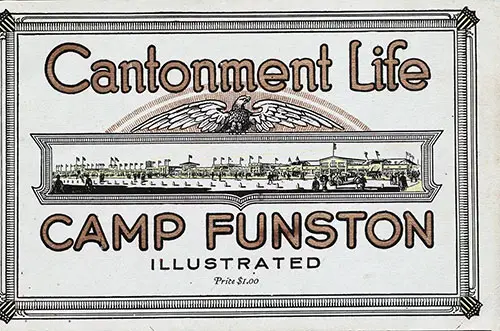
Front Cover, Camp Funston Illustrated, A Brochure About Cantonment Life, 1918. GGA Image ID # 19cdb4c4f9
In June 1917, the War Department decided to locate a large Army Cantonment on the Government Reservation at Fort Riley, Kansas. At the direction of Secretary of War Baker, Professor James S. Pray of Harvard University, engineer and expert in town planning; Mr. Wynkoop Kiersted of Liberty, Missouri, engineer, and expert on waterworks and sewerage; Herbert Hare, landscape architect of Kansas City, Missouri; and Lieutenant-Colonel (then Captain) Fred J. Herman of the Quartermaster Corps, United States Army, met at Fort Riley and selected the present site of Camp Funston.
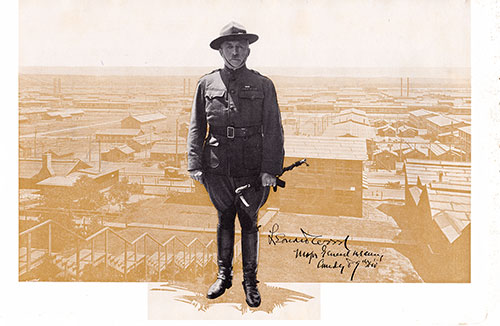
Major General Leonard Wood, Commander at Camp Funston. Camp Funston Illustrated, 1918. Image ID # 19ce6ca252
The land selected was a large meadow near the Kansas River, bounded by high bluffs on the north and the Union Pacific Railroad's mainline.
Active construction was begun July 1, 1917, and the Cantonment was completed December 1, 1917.
Camp Funston has accommodations for over 50,000 men and has been built at the cost of approximately $10,000,000.
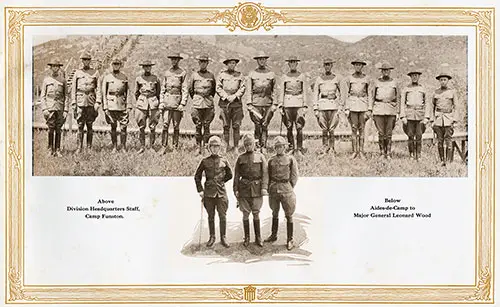
Above: Division Headquarters Staff, Camp Funston. Below: Aides-de-Camp to Major General Leonard Wood. Camp Funston Illustrated, 1918. GGA Image ID # 19cf08cc0f
It is the largest of the permanently built Cantonments and consists mainly of two-story buildings. It has complete systems of waterworks and sewers; is lighted by electricity; has its own refrigerating plants, capable of manufacturing all ice needed and refrigerating all meats, etc. It maintains its own garbage collection and disposal system and incinerators for garbage and dead animals.
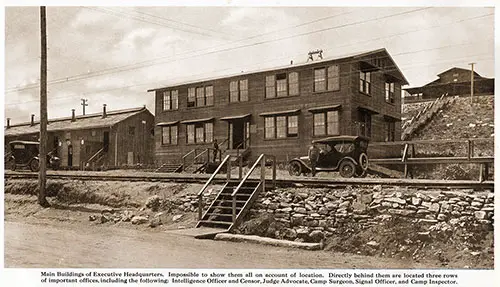
Main Buildings of Executive Headquarters. Impossible to show them all on account of location. Directly behind them are located three rows of important offices, including the following: Intelligence Officer and Censor, Judge Advocate, Camp Surgeon, Signal Officer, and Camp Inspector. Camp Funston Illustrated, 1918. GGA Image ID # 19cf79fb58
Camp Funston is the only Cantonment possessing a Zone of Camp Activities, representing an investment of over $1,500,000, financed and built by private capital, without cost to the Government, planned under the personal direction of Captain Dick B. Foster.
It is four city blocks long, containing an arcade where refreshment booths are established; complete restaurants in operation, large stores carrying complete merchandise lines for the soldiers; theatres, pool halls, picture shows, barbershops, and clothing repair shops, bowling alleys, etc.

Camp Funston Kansas. Named in honor of our Nation’s hero, General Frederick Funston. The largest of the solid built Cantonments, being of wood and mostly of two story barracks, having all the essential utilities of a city, accommodating over 50,000 men and being over two miles long. Construction of this Camp used up 47,700,000 feet of lumber and many thousands of car loads of hardware, roofing, plumber supplies, water mains, pumps, machinery, cement and equipment for the buildings and reached a cost of approximately $10,000,000. The heating system cost over $1,200,000, and notwithstanding the cost of heating system, this is the cheapest per capita of any Cantonment built. The Construction Quartermaster, upon whose shoulders this great responsibility was placed, is Lieutenant Colonel Fred J. Herman. Camp Funston Illustrated, 1918. GGA Image ID # 19cfbfad3e
Camp Funston has 14 Y.M.C.A. Buildings; three Knights of Columbus Buildings; a large library, conducted by the American Library Association; a hostess house under the auspices of the Y.W.C.A.; and numerous places of amusement and recreation.
Fourteen infirmaries are maintained as well as numerous regimental hospitals. The Base Hospital has accommodations for over 3,000 patients.
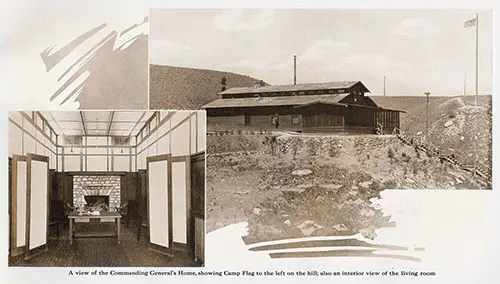
A view of the Commanding General’s Home, showing Camp Flag to the left on the hill; also an interior view of the living room. Camp Funston Illustrated, 1918. GGA Image ID # 19cfe7fd70
Camp Funston is heated by its own steam heating system, costing over a million dollars, consisting of 17 large central plants, 2 for the Base Hospital, and 37 smaller plants for a group of office buildings. Fourteen miles of steam railway and several miles of electric lines are maintained within the Camp proper.
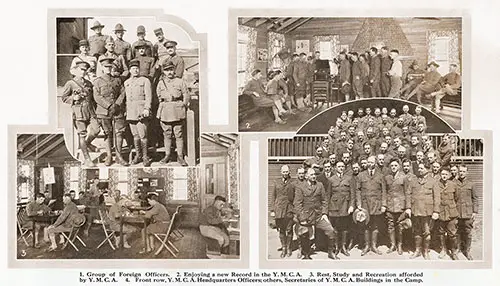
Camp Funston Collage of Foreign Officers and Views of YMCA. 1. Group of Foreign Officers. 2. Enjoying a new Record in the Y. M. C. A. 3. Rest, Study and Recreation afforded by Y. M. C. A. 4. Front row, Y. M. G. A. Headquarters Officers; others, Secretaries of Y. M. C. A. Buildings in the Camp. Camp Funston Illustrated, 1918. GGA Image ID # 19d011eaec
Camp Funston has its own fire department, adequately equipped with 12 pieces of motor apparatus and manned with 550 picked men who have had experience in the larger cities.
There are 28 miles of stone-paved streets in the Camp, eight miles of water-bound macadam and twenty macadam with asphalt border.
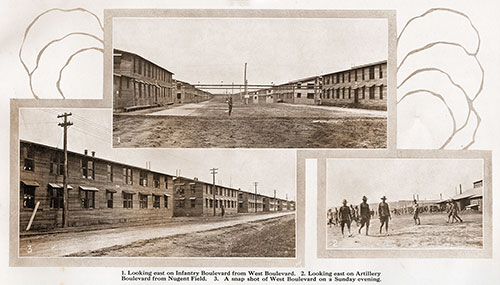
Views of Camp Funston Collage. 1. Looking east on Infantry Boulevard from West Boulevard. 2. Looking east on Artillery Boulevard from Nugent Field. 3. A snap shot of West Boulevard on a Sunday evening. Camp Funston Illustrated, 1918. GGA Image ID # 19d05a486b
The barracks for men and quarters for officers were erected for summer and winter occupancy, splendidly lighted and heated. The soldiers' barracks are two stories high and are provided with completely equipped kitchens and mess halls. Adjoining the living quarters are modern lavatories, containing shower baths with hot and cold water.
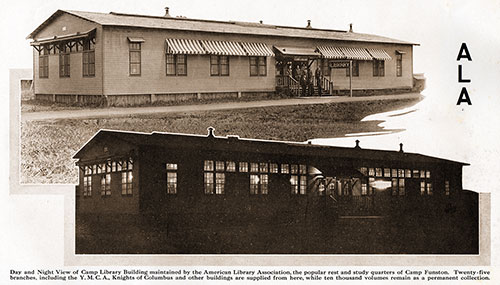
Day and Night View of Camp Library Building maintained by the American Library Association, the popular rest and study quarters of Camp Funston. Twenty-five branches, including the Y. M. C. A., Knights of Columbus and other buildings are supplied from here, while ten thousand volumes remain as a permanent collection. Camp Funston Illustrated, 1918. GGA Image ID # 19d05acea7
The police force of Camp Funston consists of the military police, a special organization.
Suitable buildings are provided at division headquarters for foreign officers and officers on duty as instructors in trench warfare, as attacks, defense, etc., developed in the last three years.
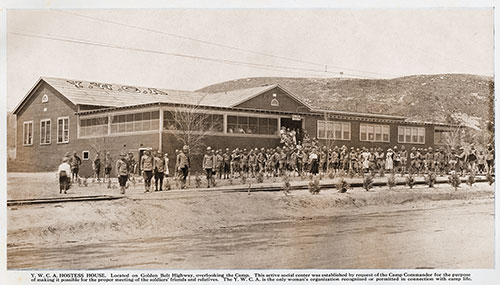
Y. W. C. A. Hostess House. Located on Golden Belt Highway, overlooking the Camp. This active social center was established by request of the Camp Commander for the purpose of making it possible for the proper meeting of the soldiers’ friends and relatives. The Y. W. C. A. is the only woman’s organization recognized or permitted in connection with camp life. Camp Funston Illustrated, 1918. GGA Image ID # 19d0a2a333
At no time in the world's history has the soldier been so well cared for as he is today in Cantonments and Army Posts of the United States. Wherever criticism has been heard, it has emanated from the mouths of the uninformed, the ignorant, and from willful misrepresentations based on a lack of technical, sanitary, and military knowledge.
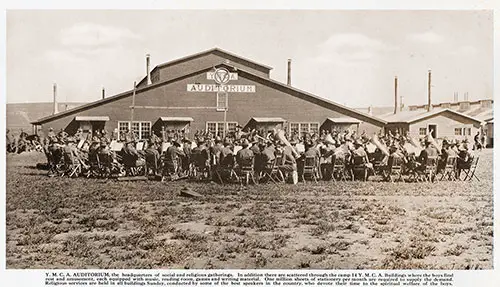
Y. M. C. A. Auditorium, the headquarters of social and religious gatherings. In addition there are scattered through the camp 14 Y. M. C. A. Buildings where the boys find rest and amusement, each equipped with music, reading room, games and writing material. One million sheets of stationery per month are required to supply the demand. Religious services are held in all buildings Sunday, conducted by some of the best speakers in the country, who devote their time to the spiritual welfare of the boys. Camp Funston Illustrated, 1918. GGA Image ID # 19d148d31b
CAMP FUNSTON KANSAS
Named in honor of our Nation's hero, General Frederick Funston. The largest of the solid built Cantonments, being of wood and mostly of two-story barracks, having all the essential necessities of a city, accommodating over 50,000 men, and being over two miles long.
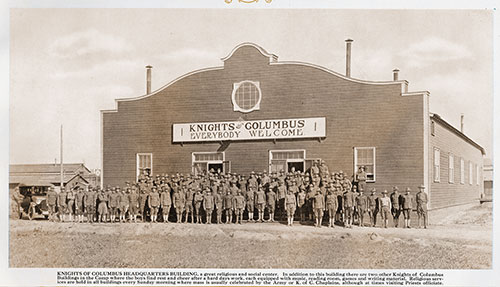
Knights of Columbus Headquarters Building, a great religious and social center. In addition to this building there are two other Knights of Columbus Buildings in the Camp where the boys find rest and cheer after a hard days work, each equipped with music, reading room, games and writing material. Religious services are held in all buildings every Sunday morning where mass is usually celebrated by the Army or K. of C. Chaplains, although at times visiting Priests officiate. Camp Funston Illustrated, 1918. GGA Image ID # 19d14c1263
Construction of this Camp used up 47,700,000 feet of lumber and many thousands of carloads of hardware, roofing, plumber supplies, water mains, pumps, machinery, cement, and equipment for the buildings and reached a cost of approximately $10,000,000.
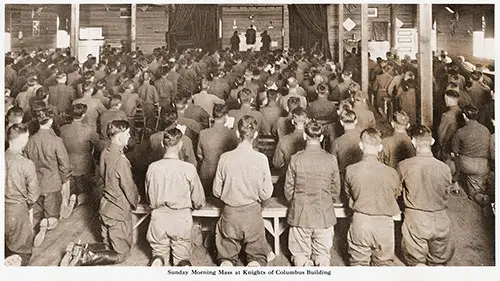
Sunday Morning Mass at Knights of Columbus Building. Camp Funston Illustrated, 1918. GGA Image ID # 19d2a2c102
The heating system cost over $1,200,000, and notwithstanding the cost of the heating system, this is the cheapest per capita of any Cantonment built. The Construction Quartermaster, upon whose shoulders this great responsibility was placed, is Lieutenant Colonel Fred J. Herman.
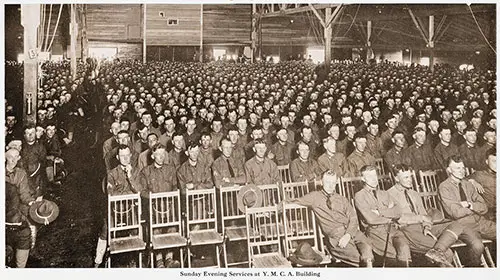
Sunday Evening Services at Y. M. C. A. Building. Camp Funston Illustrated, 1918. GGA Image ID # 19d2d5cf64
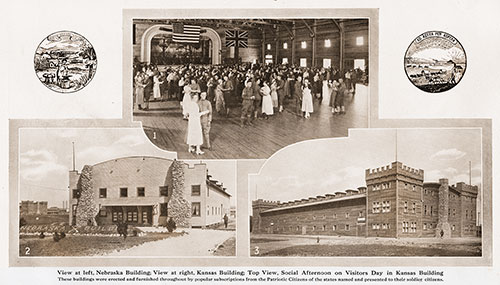
View at left, Nebraska Building; View at right, Kansas Building; Top View, Social Afternoon on Visitors Day in Kansas Building. These buildings were erected and furnished throughout by popular subscriptions from the Patriotic Citizens of the states named and presented to their soldier citizens. Camp Funston Illustrated, 1918. GGA Image ID # 19d2eca1bd
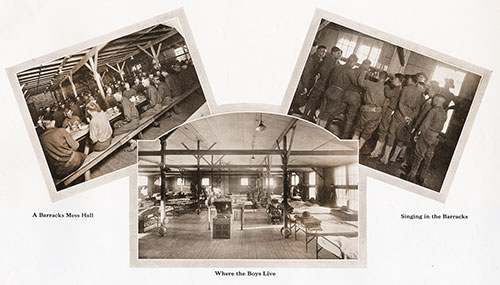
Left: A Barracks Mess Hall. Right: Singing in the Barracks. Center: Where the Boys Live. Camp Funston Illustrated, 1918. GGA Image ID # 19d2fc9fbd
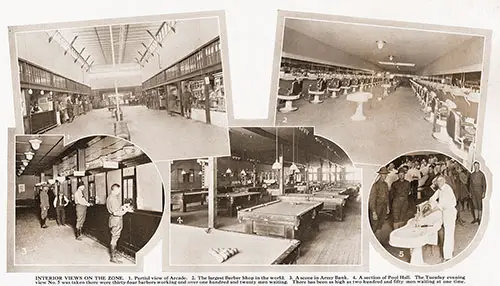
Interior Views on the Zone at Camp Funston. 1. Partial view of Arcade. 2. The largest Barber Shop in the world. 3. A scene in Army Bank. 4. A section of Pool Hall. The Tuesday evening view No. 5 was taken there were thirty-four barbers working and over one hundred and twenty men waiting. There has been as high as two hundred and fifty men waiting at one time. Camp Funston Illustrated, 1918. GGA Image ID # 19d33c4b32
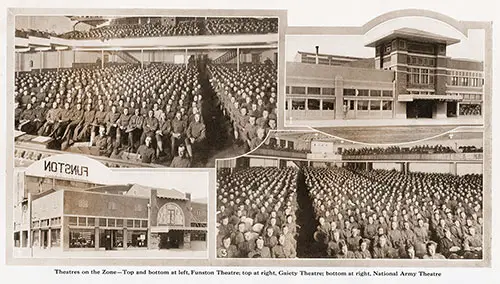
Theatres on the Zone at Camp Funston—Top and bottom at left, Funston Theatre; top at right, Gaiety Theatre; bottom at right, National Army Theatre. Camp Funston Illustrated, 1918. GGA Image ID # 19d34864a4
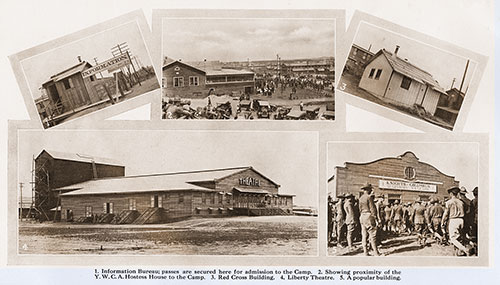
Popular Buildings at Camp Funston. 1. Information Bureau; passes are secured here for admission to the Camp. 2. Showing proximity of the Y. W. C. A. Hostess House to the Camp. 3. Red Cross Building. 4. Liberty Theatre. 5. A popular building. Camp Funston Illustrated, 1918. GGA Image ID # 19d3770862
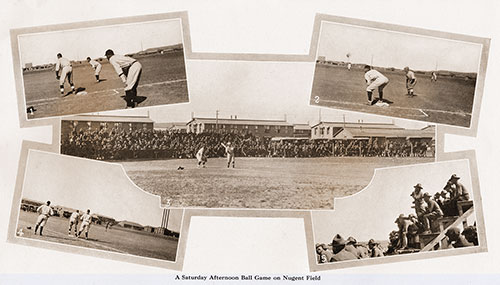
A Saturday Afternoon Ball Game on Nugent Field. Camp Funston Illustrated, 1918. GGA Image ID # 19d38ec39a
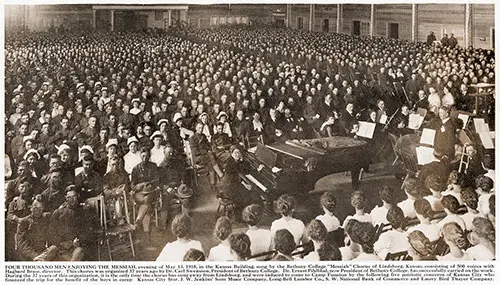
Four Thousand Men Enjoying the Messiah, evening of May 13, 1918, in the Kansas Building, sung by the Bethany College “Messiah” Chorus of Lindsborg, Kansas, consisting of 500 voices with Hagbard Brase, director. This chorus was organized 37 years ago by Dr. Carl Swensson, President of Bethany College. Dr. Ernest Pihlblad, now President of Bethany College, has successfully carried on the work. During the 37 years of this organization, it is the only time the chorus has sung away from Lindsborg, and were induced to come to Camp Funston by the following five patriotic concerns of Kansas City who financed the trip for the benefit of the boys in camp: Kansas City Star, J. W. Jenkins’ Sons Music Company, Long-Bell Lumber Co., S. W. National Bank of Commerce and Emery Bird Thayer Company. Camp Funston Illustrated, 1918. GGA Image ID # 19d40ccb82
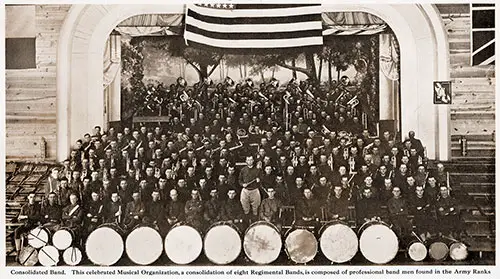
Consolidated Band at Camp Funston. This celebrated Musical Organization, a consolidation of eight Regimental Bands, is composed of professional band men found in the Army Ranks. Camp Funston Illustrated, 1918. GGA Image ID # 19d410a41d
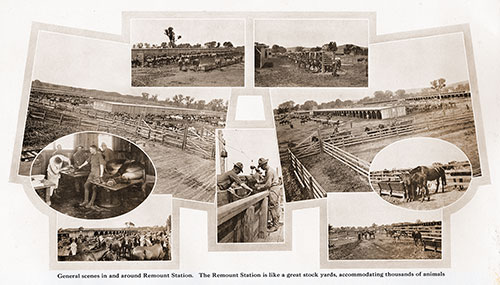
General scenes in and around Remount Station. The Remount Station is like a great stock yards, accommodating thousands of animals. Camp Funston Illustrated, 1918. | GGA Image ID # 19d418aad8
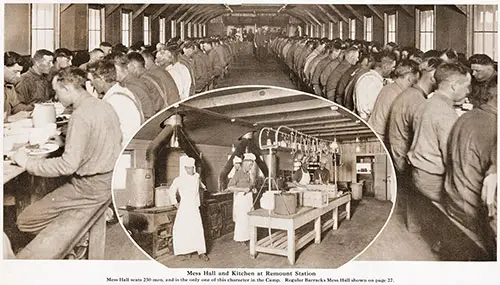
Mess Hall and Kitchen at Remount Station. Mess Hall seats 250 men, and is the only one of this character in the Camp. Regular Barracks Mess Hall shown on page 27. Camp Funston Illustrated, 1918. GGA Image ID # 19d41d06d8
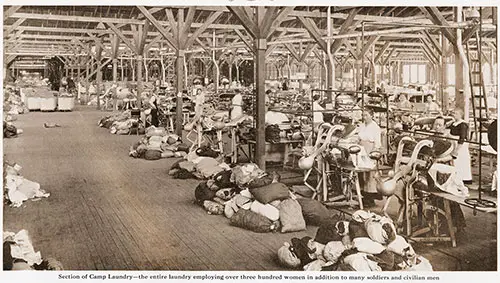
Section of Camp Laundry—the entire laundry employing over three hundred women in addition to many soldiers and civilian men. Camp Funston Illustrated, 1918. GGA Image ID # 19d469fdb7
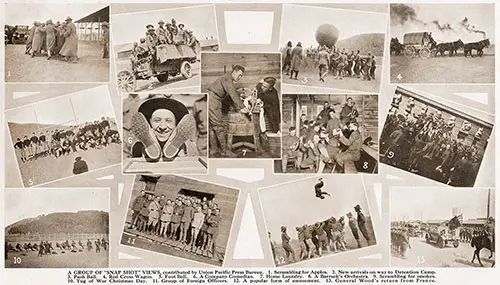
A Group of “Snap Shot” Views, contributed by Union Pacific Press Bureau. 1. Scrambling for Apples. 2. New arrivals on way to Detention Camp. 3. Push Ball. 4. Red Cross Wagon. 5, Foot Ball. 6. A Company Comedian. 7. Home Laundry. 8. A Barrack’s Orchestra. 9. Scrambling for smokes. 10. Tug of War Christmas Day. 11. Group of Foreign Officers. 12. A popular form of amusement. 13, General Wood’s return from France. Camp Funston Illustrated, 1918. GGA Image ID # 19d47107ee
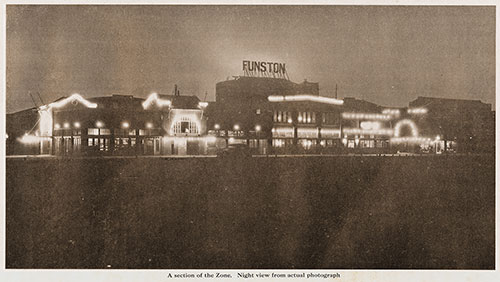
A section of the Zone at Camp Funston. Night view from actual photograph. Camp Funston Illustrated, 1918. GGA Image ID # 19d4970989
